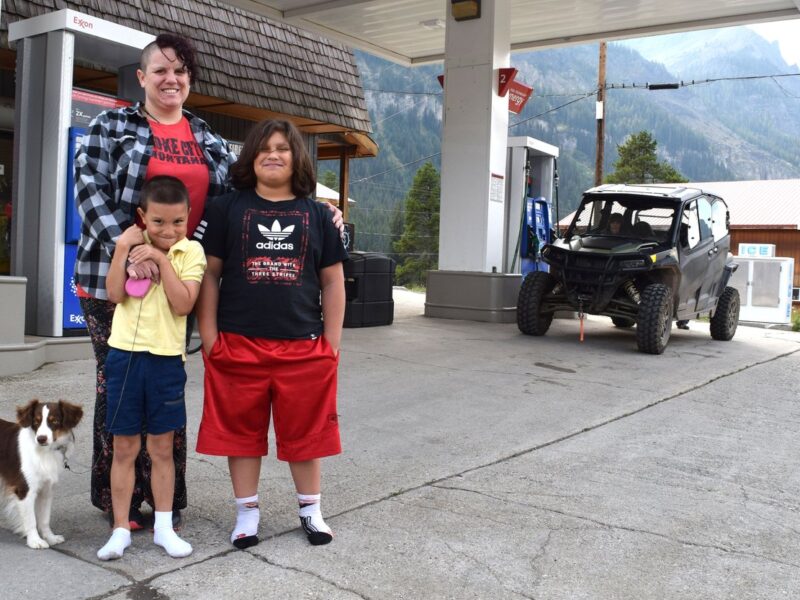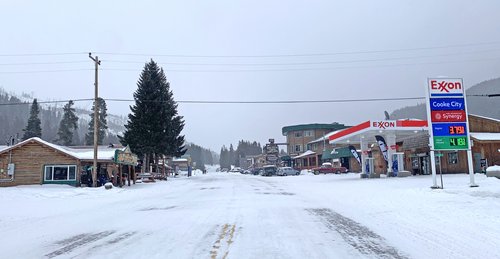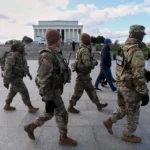Push Grows to “Plow the Plug” (Part 1)
Long-simmering dispute heats up over equal access to public highway
- Published In: Other News & Features
- Last Updated: Jan 21, 2023

Joelle Passerello manages a gas station in Cooke City, Mont., where she lives with her sons Xavier, left, and Charlie, along with their dog, Tippie. Passerello is among a majority of residents in the area seeking to plow a section of U.S. Highway 212 that blocks her access to nearby shopping and medical care in Wyoming and Montana. (Wyoming Truth photo by Ruffin Prevost)
By Ruffin Prevost
Special to the Wyoming Truth
CODY, Wyo. — Living in a remote mountain community can come with unique challenges. But that’s something Joelle Passerello knew in 2019 when she moved to Cooke City, Mont., a tourist town literally at the end of the road.
Passerello, a single mother of two, manages a gas station in the isolated mountain town located just outside the Northeast Entrance to Yellowstone National Park. In the winter, the only way in or out of town is a 55-mile trek through the park’s northern range to Gardiner, Mont. The Northeast Entrance Road dead-ends at the eastern edge of Cooke City, blocked by an eight-mile section of snow-covered U.S. Highway 212 that remains unplowed for the season.

During the summer, Passarello shops at the nearest Walmart, in Cody, and travels there or to Billings, Mont. for health care at the U.S. Department of Veterans Affairs. But this time of year, the unplowed “plug,” as locals call it, means her follow-up appointments after an October surgery require the Air Force veteran to make a 550-mile round trip.
“I knew there were going to be issues, and I would have to plan accordingly,” said Passarello, who has to pull her kids from school and rent a hotel room for such trips. “But I never thought it would be this complicated.”
For decades, the National Park Service has plowed the Northeast Entrance Road through the Lamar Valley, connecting Gardiner and nearby park headquarters in Mammoth Hot Springs, Wyo. to the tiny Montana outposts of Silver Gate and Cooke City, which lie just outside the park’s Northeast Entrance.
The Wyoming Department of Transportation and Park County, Wyo. have traditionally plowed the Chief Joseph Scenic Highway and a section of U.S. Highway 212 to Pilot Creek, a little more than four miles south of the Montana border, and just over eight miles southeast from Cooke City. That has allowed snowmobilers coming from Wyoming to use a parking area at Pilot Creek for parking trucks, trailers and campers. The eight-mile section of unplowed road lets them sled to Cooke City and easily access a network of backcountry trails along the way.
But record floods in June washed out wide sections of roads in Yellowstone, including the Northeast Entrance Road. Those closures cut off park visitor access to Cooke City from the west until October, wrecking the local tourist economy for the season. It also left residents feeling vulnerable to future unforeseen incidents, and sparked a grassroots community movement to “plow the plug” in winter, a goal pursued for decades by advocates in Montana and Wyoming.
Proponents of plowing say it will increase winter tourism in the region by allowing auto travel from Gardiner to Cody. It would boost wolf watching, skiing, snowshoeing, ice climbing and other Cooke City area activities unavailable to those arriving from the Wyoming side, except by snowmobile. They also cite health and safety issues related to long delays for emergency services as a key concern, as well as a desire to use a public highway year-round.

After the June floods, advocates of plowing formed the Park Access Recommendation Committee (PARC), pushing to plow the plug. They have gathered cost estimates and met with public officials, and later this month will ask Park County Montana Commissioners to formally request that Gov. Greg Gianforte plow the road.
Not so simple
That request is one step in the process, but the problem is not so simple. The plug straddles the Montana/Wyoming border, crossing through two counties and two national forests. Plowing it would require a new funding and cooperation between a wide range of local, state and federal agencies.
Not to mention addressing concerns from snowmobile riders.
While not all sledders oppose plowing the plug, a vocal minority are either against plowing under any circumstances, or they want to first see additional new trail infrastructure developed.
“This has been a wonderful trail for over 40 years,” said Bert Miller of Cody, a member of Protect Our Plug (POP), a group formed in opposition to plowing, and in response to PARC’s efforts.
“It brings in a lot of revenue to Cooke City, and if it was looked at further at being plowed, we would first insist on having new parking areas and a new trail put in” that would parallel the plowed road section, said Miller, a director of the Cody Country Snowmobile Association.
Miller said the plug serves as a connector trail between two vast expanses of backcountry sledding territory, and that plowing it would make the region less attractive to snowmobilers who like to spend the night in Cooke City for a “sled-to-bed” experience. Plowing the road without a new trail and parking would be “economically devastating,” he said.
Despite the high stakes, Miller said he has not approached PARC members about finding a workable solution.
But a study proposed Thursday by the Cody-based Park County Travel Council to be funded with state lodging tax revenue would examine options for increasing winter recreation of all kinds in the area, while also addressing desires to plow the road, increase parking and create a new trail.
Such a wide-ranging resolution has been discussed in the past, but never seriously pursued. Whether this time will be different—much less successful—remains a vexing and unanswered question.
Check back tomorrow for part two.
DISCLOSURE: Ruffin Prevost is a member of the Park County Travel Council board of directors. The organization does not have a position on plowing the plug.













